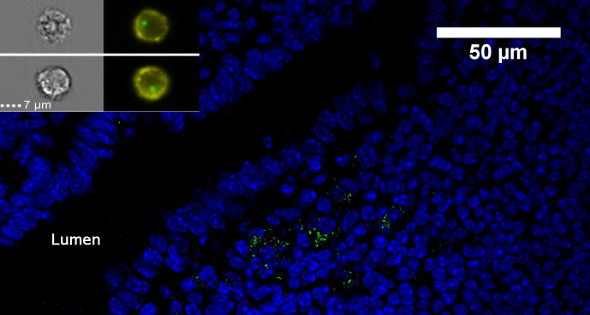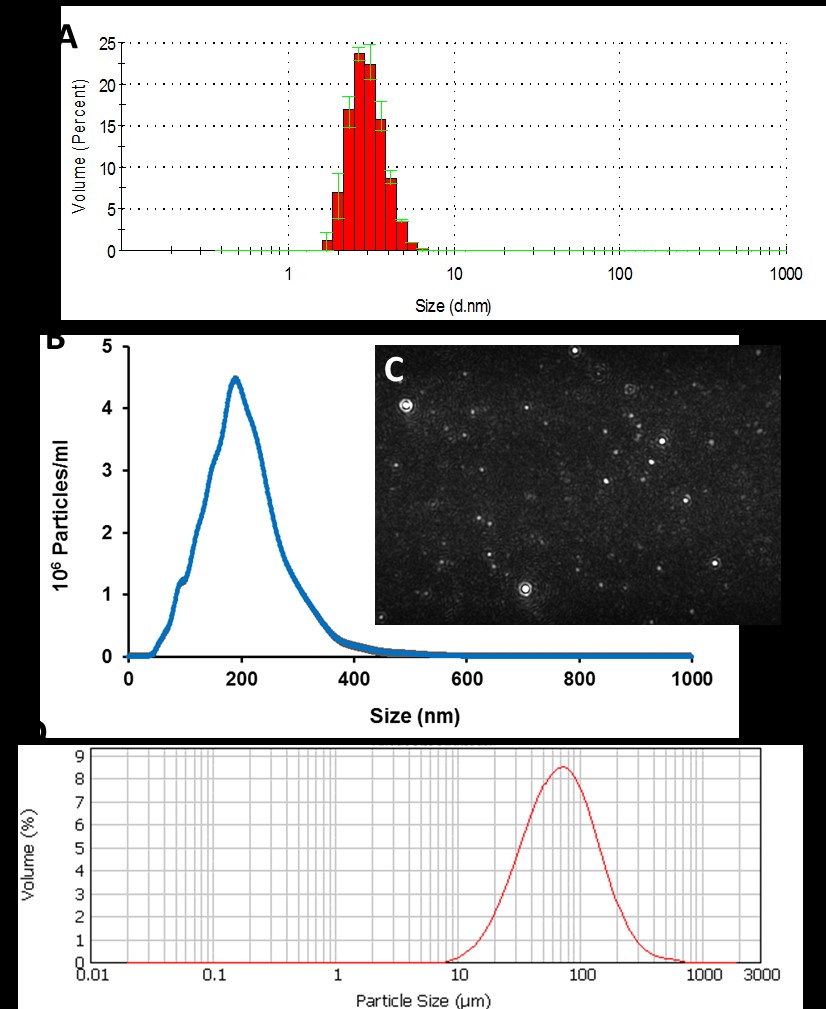Biomineral Research: Applying Mineral Science and Technology to Bio-Clinical Problems.
The Aim: we seek to understand how nanostructured minerals, of either endogenous or exogenous origin, contribute to normal health or pathology, and thus how engineered mineral structures can be exploited for therapeutic or diagnostic benefit. Diseases of interest are (i) cancer and (ii) autoimmune/inflammatory disorders, especially Crohn’s disease. Key techniques are quantitative cell imaging, ICP analysis and particle sizing.
Endogenous Intestinal Nanoparticles. Regarding gastrointestinal processing, we are investigating how soluble antigen and bacterial fragments (e.g. TLR and NLR ligands) of the intestinal lumen form conjugates with endogenously secreted calcium and phosphate ions which then, as nanoparticulate constructs, are shuttled to intestinal immune cells (1). Of particular interest is what benefit this apparently commonplace constitutive process affords the host and how or why it might fail in Crohn’s disease (2).
Nanomineral lessons from Nature. More broadly, our research has shown that endogenous nanomineral forms have some distinct advantages over their soluble counterparts, ranging from reduced toxicity (such as the redox activity of iron) to unique cell uptake and signalling effects. We synthesise ‘bio-inspired’ analogues which, for example, has given rise to affordable but safer and better tolerated forms of oral iron than are currently commonly prescribed (3,4).
Engineered Nanominerals for Therapeutic Benefit. The main thrust of our current and future work is to use nanomineral technologies to help address strategic priorities in the bio-clinical arena. For example, nanominerals can be engineered to skew immune signalling for therapeutic benefit, which then dissolve to benign or beneficial soluble minerals thereby limiting downstream bystander effects. Silicate clusters are one focus: having observed their endogenous formation in lower animals (5) we are now working on engineered synthetic analogues and their immune cell-modifying properties. These dissolve to form orthosilicic acid which is well controlled homeostatically through renal excretion (6). A second focus is on synthetic mimetics of endogenous intestinal nanoparticles and the delivery of bio-active cargo to discrete immune-inductive sites of the gut. Again, following delivery, these dissolve and join the common soluble ion pool for this pathway.
Quantitative Cell Imaging. Inspired by the need to map mineral particles at the single-cell level in situ we are working on novel processes for quantitative cell imaging by flow techniques in whole blood (7) as well as in tissue sections. These have broader applications than particle tracking, especially as a new diagnostic technique with histology and immunohistochemistry. Dr John Wills has been awarded a Herchel Smith Fellowship to join the group from Oct 2017 and to work on the application of such techniques to better our understanding of Crohn's disease.
The Population and Oral Nanoparticle Exposure. The group also has a long standing interest in population exposure to exogenous nano and micron sized mineral particles via the oral route. In particular we are studying how the intestinal endogenous nanomineral route, described above for calcium phosphate constructs, might be ‘hijacked’ by ingested particles that are derived from a Western lifestyle. Exposure to titanium dioxide pigment particles, for example, is common (8). These particles are not digested and we have shown that some accumulate in the human gut (8) whilst others are absorbed systemically by humans (9). Whether such exposure and uptake has any impact on population health is currently a matter of significant interest in the field.
Analysis and Specialist Skill Sets. In all of our work we draw on our skills in (a) structured mineral engineering (b) particle sizing (c) microscopy and flow imaging techniques and (d) ICP analysis, as exemplified in the figures shown here.



